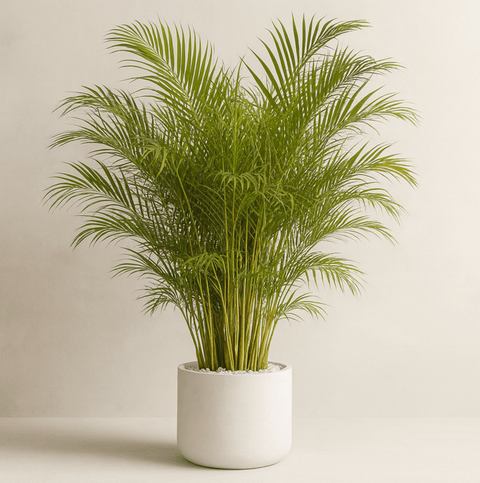Blog Post - Ficus Lyrata Care
Click here to jump to section II: Getting to know Ficus Lyrata
Click here to jump to section III: Light Requirements
Click here to jump to section IV: Temperature and Humidity
Click here to jump to section V: Watering and Soil
Click here to jump to section VI: Fertilizing
Click here to jump to section VII: Pruning and Maintenance
Click here to jump to section VIII: Common Problems and Solutions
Click here to jump to section IX: Propagation
Click here to jump to section X: Conclusion
The Complete Guide to Ficus Lyrata Care: Tips for Keeping Your Fiddle-Leaf Fig Healthy and Thriving
Taking care of indoor plants not only adds beauty to your home but also brings numerous benefits to your well-being. Among the many popular choices of indoor plants, Ficus Lyrata, commonly known as the Fiddle-Leaf Fig or Ficus Pandurata, stands out for its large, striking leaves and ability to thrive in indoor environments. In this comprehensive guide, we will explore all aspects of caring for Ficus Lyrata, from lighting and temperature requirements to watering, soil, and maintenance tips. Get ready to bring the beauty of nature indoors with your own Fiddle-Leaf Fig!
II. Getting to know Ficus Lyrata

Ficus Lyrata is native to the tropical rainforests of West Africa, where it grows as an epiphyte, naturally climbing and attaching itself to other trees. Its distinctive leaves, resembling the shape of a fiddle or lyre, give it its common names, Fiddle-Leaf Fig or Ficus Pandurata. These impressive leaves not only make Ficus Lyrata an attractive addition to any indoor space but also serve a purpose in the plant's natural habitat by collecting rainwater in their concave shape.
III. Light Requirements

Providing the right amount of light is crucial for the health and growth of your Fiddle-Leaf Fig. Ficus Lyrata thrives in bright, indirect light, simulating the dappled sunlight it would receive in its natural rainforest habitat. It is important to find the right spot in your home that offers bright, filtered light without direct exposure to harsh sunlight, which can scorch the leaves. Consider placing your Fiddle-Leaf Fig near a north or east-facing window, or use sheer curtains or blinds to filter the light.
IV. Temperature and Humidity
Maintaining an appropriate temperature range is essential for the well-being of your Ficus Lyrata. Ideally, the temperature should be kept between 60-85°F (16-29°C), avoiding extreme cold or heat. Consistency is key, as drastic temperature fluctuations can stress the plant. Additionally, Fiddle-Leaf Figs thrive in relatively high humidity conditions, so it is beneficial to increase humidity levels around the plant by using a humidifier or placing a tray of water nearby. However, avoid misting the leaves directly, as this can lead to fungal issues.
V. Watering and Soil

Proper watering is vital to keep your Ficus Lyrata healthy. It is important to strike a balance between overwatering, which can lead to root rot, and underwatering, which can cause leaf drooping and browning. Allow the top few inches of soil to dry out between waterings and then provide a thorough watering, ensuring excess water drains out of the pot. Choosing a well-draining potting mix and a container with drainage holes will help prevent waterlogging and promote healthy root growth.
VI. Fertilizing
Ficus Lyrata benefits from regular fertilization to support its growth and overall health. Use a balanced liquid or slow-release fertilizer suitable for indoor plants and follow the recommended dosage instructions. During the growing season, which typically occurs in spring and summer, fertilize your Fiddle-Leaf Fig once a month. In the dormant season, reduce the frequency to every two to three months. Be cautious not to over-fertilize, as this can cause salt build-up and damage the plant roots.
VII. Pruning and Maintenance

Regular pruning is essential for maintaining the shape and size of your Ficus Lyrata and promoting healthy growth. Prune any yellowing or damaged leaves, as well as any branches that are overcrowding the plant or growing in unwanted directions. Use clean, sharp pruning shears and make clean cuts just above leaf nodes or branch junctions. Additionally, wiping the leaves with a damp cloth occasionally will help remove dust and keep them looking vibrant.
VIII. Common Problems and Solutions
While Ficus Lyrata is a relatively low-maintenance plant, it can still face some common issues. Leaf yellowing, brown spots, and leaf drop are often signs of over or underwatering, incorrect lighting, or pests. Regularly inspect your Fiddle-Leaf Fig for any signs of pests such as mealybugs, scale insects, or spider mites. If pests are present, treat them promptly using organic pest control methods or insecticidal soap.
IX. Propagation

If you want to expand your Ficus Lyrata collection or share the beauty of these plants with others, propagation is a great option. Propagating Fiddle-Leaf Figs can be done through stem cuttings. Take a healthy stem cutting with a few leaves and place it in a container filled with moist, well-draining soil. Keep the soil consistently moist, provide the cutting with indirect light, and within a few weeks, roots should begin to develop. Once rooted, transplant the new plant into its own pot, and soon you'll have a new Ficus Lyrata to care for!
X. Conclusion
Caring for Ficus Lyrata, or the Fiddle-Leaf Fig, doesn't have to be a daunting task. By understanding its specific needs for light, temperature, humidity, watering, fertilizing, and maintenance, you can ensure your Fiddle-Leaf Fig thrives in your indoor space, adding beauty and a touch of nature to your home. With the information and tips provided in this guide, you are well-equipped to embark on your journey of Ficus Lyrata care. So go ahead, bring the elegance and charm of Fiddle-Leaf Figs into your home and enjoy the benefits of a healthy, thriving indoor plant!























Comments (0)
There are no comments for this article. Be the first one to leave a message!